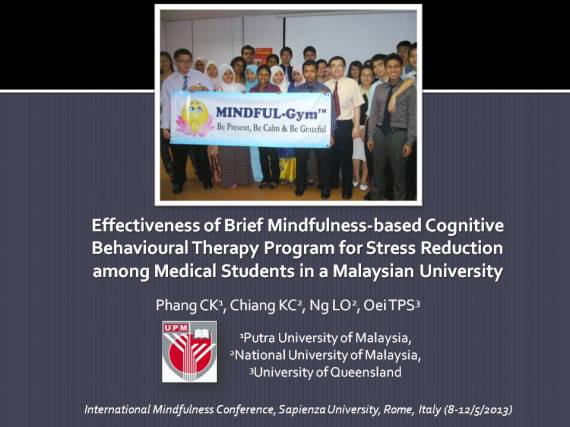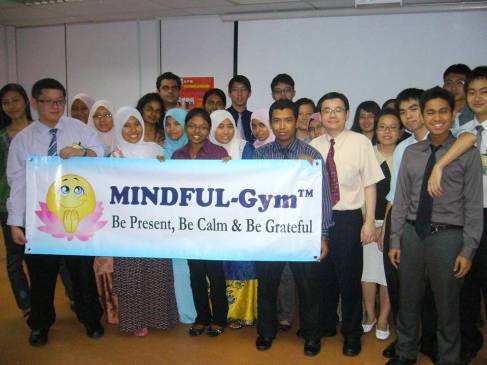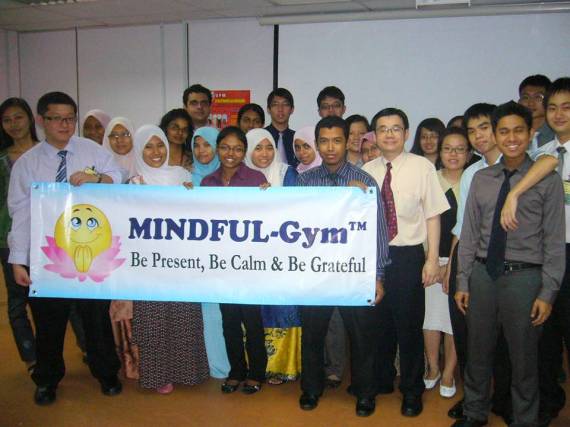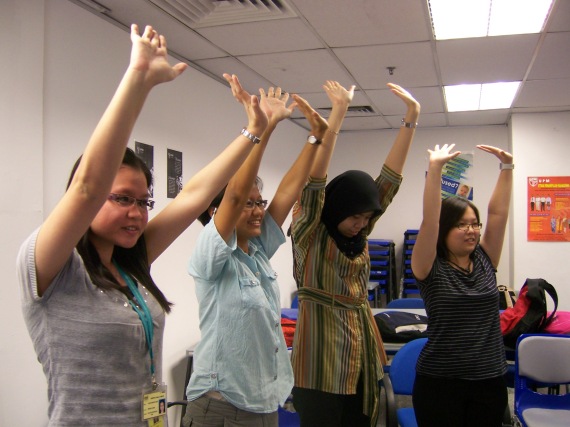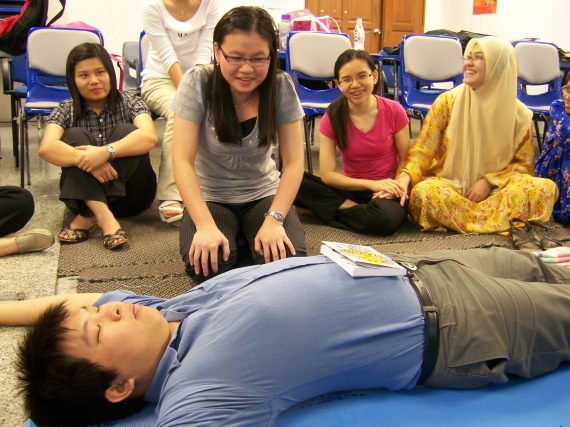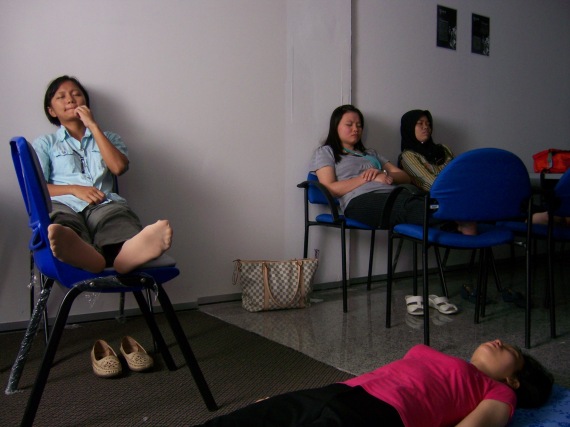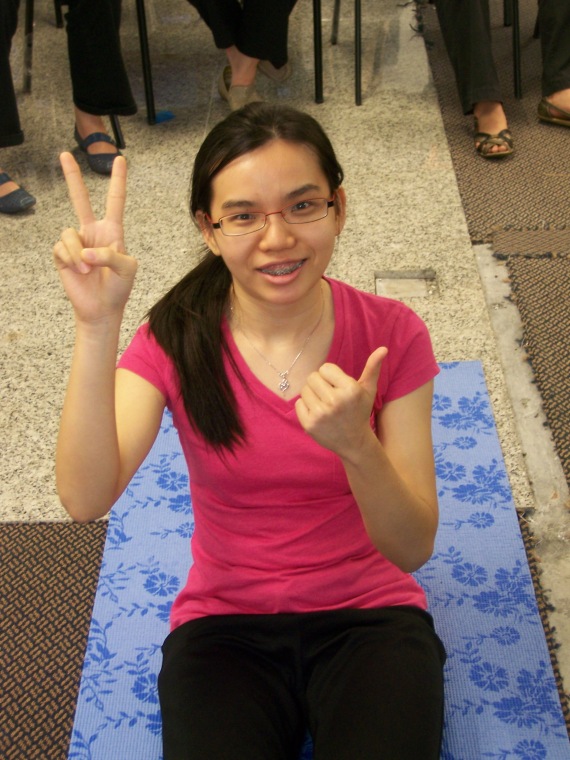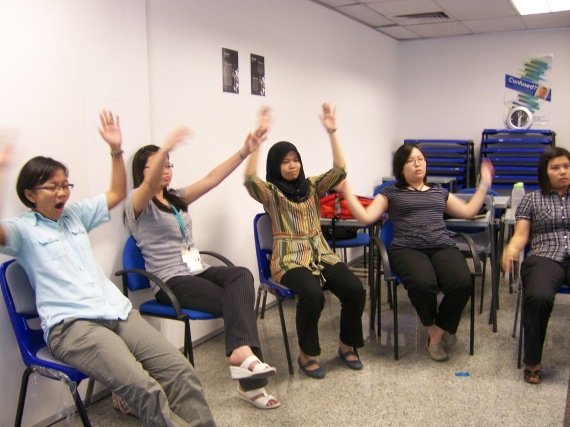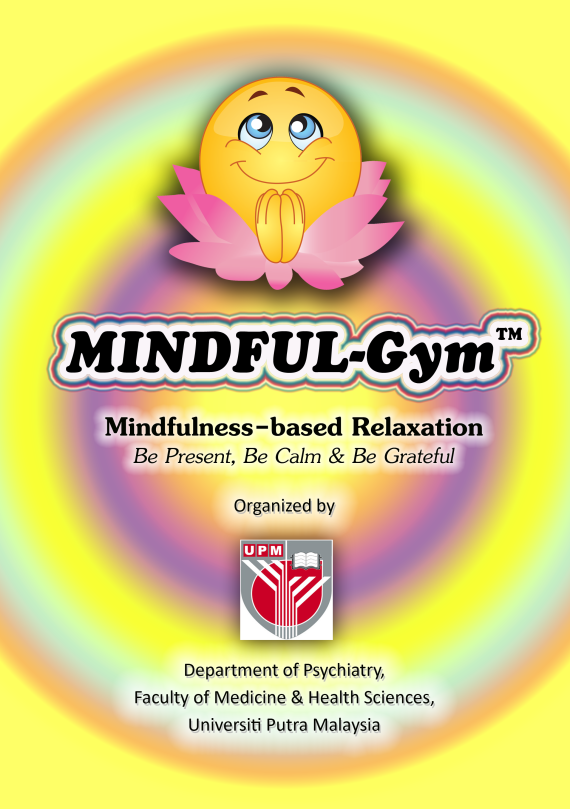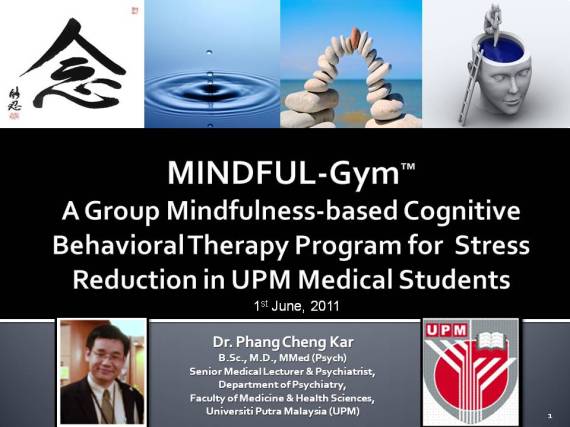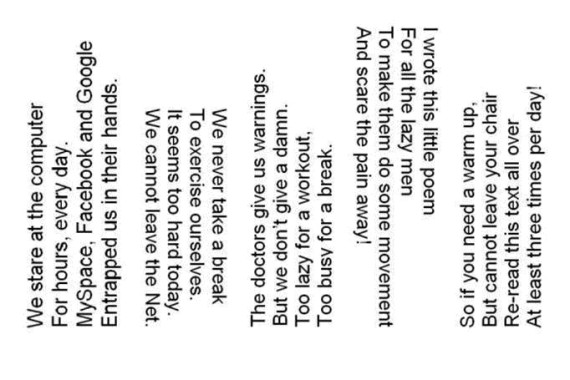Slides available from HERE.
24 Nov
Mindful-Gym MS: Program Outline
MINDFUL-Gym™ MS is a mindfulness-based stress reduction & wellness program which is specially tailored for medical students to cope with stress. It consists of 5 weekly two-hour experiential and participatory lessons with daily self-help & home-based practice (Home-Gym). It’s held at the Faculty of Medicine & Health Sciences, UPM. The program is organized by the Department of Psychiatry, UPM & will be conducted by Dr. Phang Cheng Kar, a lecturer & psychiatrist from UPM. Participation is on voluntary basis & it’s free of charge.
Program Outline:
Week 1:
- ABC of Stress
- Introduction to Mindfulness
- Happiness is Here-and-Now
- Progressive Muscle Relaxation
- Home-Gym
Week 2:
- Review of Home-Gym
- Mindful-scope & beginner’s mind
- Deep Relaxation & Mindful Breathing
- 4 Pleasant States Imagery
- Mindful-S.T.O.P. (Basic)
- Home-Gym
Week 3:
- Review of Home-Gym
- Body Scan & Kindness
- Biofeedback game
- ‘3-G Gratitude’ Workout
- Mindful-S.T.O.P. (Advance)
- Home-Gym
Week 4:
- Review of Home-Gym
- Mind-Scan I – Identifying Thinking Errors
- Lake/Mountain Meditation
- Home-Gym
Week 5:
- Review of Home-Gym
- Mind-Scan II – Transforming Thinking Errors
- MP3 – Mindfulness Personal Practice Package
Benefits:
24 Nov
Mindful-Gym for Medical Students – Testimonial
Very relaxing, joyful and free of academic assignments.
It’s inspiring listening to the stories and sharing of experience.
The complimentary book, “Don’t Worry, Be Happy” should be given to all medical students since year one…an excellent read.
I like the ‘pleasant imagery’ as it helps me to relax.
Can relax every Friday after hectic lectures during the weekdays.
Dr. Phang is my role model to be calm, relax and free of tension with bright smile on his face. I’m really inspired because even though his father has just passed away, he can still mindful-gym and guide us for our exam preparation.
I find ‘hypno-relaxation & confidence building’ very helpful.
It really helps me to relax and remember to enjoy the small things in life. Nowadays, I sleep better and have lesser muscle aches. Thanks to PMR and ‘pleasant states imagery.’ But I think the best part about Mindful-Gym is Dr. Phang himself. So, thank you Doc for taking time & guiding us.
Singing the songs together with all my course mates is the best part that I have benefited from the program. I hope this program can be introduced to more medical students.
I like the PMR and deep breathing techniques. They help me to reduce my tension under stressful situations. I also become calmer when facing situations like presenting cases to lecturers.
It helps me to think more positively & this really relieves stress.
The most relaxing ‘class’ I ever had! I like the way Dr. Phang conducted the sessions. Hope we can still join Mindful-Gym in other postings.
All the techniques are easy and simple to practice.
We can practice the techniques for ourselves & also teach our patients.
‘Be present, be calm & be grateful.” I like the whole concept of this program as we tend to look back to our past or forward to the future, and forget the current moment. It’s a good program to remind us about mindfulness & various ways of stress reduction. This is good as different people have different preference in ways for relaxation.
I like the wonderful time with my group mates and Dr. Phang, especially the fun and laughing. It’s a time to relax our mind. I like all the activities in Mindful-Gym.
Thank you for running the program. I find it very useful and I’m grateful to be able to participate in this program.
Very thankful meeting you, doctor. I want to be as dedicated as you.
I like the 3G-Yahoo exercise. I’m now more able to be aware of the happy moments in life.
It’s the best program conducted for medical students.
It’s the only time that I can escape from my world of books and just laugh…do nothing but just laugh….Dr. Phang is a good and positive person.
Mindful-Gym…Yahoo!!
The activity that I like most is progressive muscle relaxation. It’s useful & really helps.
I like deep breathing. The mind can be emptied by doing this.
The book, “No Worry-Lah, Be Happy,” has benefited me a lot. It should be sold or given to all UPM medical students. Thank you Dr. Phang for your time and motivation.
I’m doing something useful that fills up my time. If I don’t join the program, I might probably be sleeping in my room.
It’s a fun program…learn to be relax and optimistic.
The best session about Mindful-Gym was when we were given chocolate, Yahoo! It is an enjoyable program. Yeah, we are also rewarded with a FREE book for joining this program.
Very good for relaxation…have longer sessions.
28 Nov
MINDFUL-Gym for MS – 2013
Mindful-Gym for Medical Students
Program outline
Testimonial by students
Mindful-Gym photos
Survey on preference of day/time
3 Jun
MINDFUL-Gym for Medical Students
This was presented on behalf of the Department of Psychiatry at the Faculty of Medicine & Health Sciences, University Putra Malaysia (UPM) on 1/6/2011 as part of CME. Participation in the 4-week MINDFUL-Gym program (N = 53) was significantly associated with reduced level of stress (GHQ & PSS), increased level of mindfulness (MAAS), and higher marks in end of psychiatric posting exam. Slides can be downloaded from HERE. Happy MINDFUL-Gyming.
1 Nov
10 Tips For Mindful Doctoring
By Riva Greenberg
My 10 recommendations to turn a patient visit into a mindful healing encounter
1. Greet me by looking at me, call me by name and smile. Knowing you see me makes me more encouraged I’ll get good results working with you.
2. Point out where I should sit if it’s not obvious. Having you take charge of the small things helps reduce my anxiety about the big things.
3. Ask me a few personal questions. It energizes me and stimulates my thinking. This may help you better diagnose the problem.
4. Look at me when you talk to me. The eye-to-eye connection makes me feel that whatever is wrong you will help me get through it.
5. Use language I understand and speak slowly enough for me to follow. If I understand the issue I can better weigh my options and/or know what to do and why it’s important. This affects whether or not I follow your instructions.
6. Ask me if I have any questions and listen to the whole question before you answer. Listening attentively you may also hear what I’m afraid to ask.
7. Be thoughtful in what you say and do. I am there because something is wrong and I am worried. Your understanding will help me to do better, your criticism will add to the problem.
8. Reserve judgment. It will help me hear you.
9. Ask me to repeat back to you any instructions you give me. That way we will both know I have understood what to do.
10. Ask me if I have any questions at the end of the visit. If I do, answering them will help me take any necessary actions. If I don’t, you’ll have given me a dose of kindness and respect.
http://www.huffingtonpost.com/riva-greenberg/10-tips-for-mindfulness-t_b_706568.html
21 Oct
How Mindfulness Can Make For Better Doctors
By PAULINE W. CHEN, M.D.
Published: October 15, 2009
New York Times
One night during my training, long after all the other doctors had fled the hospital, I found a senior surgeon still on the wards working on a patient note. He was a surgeon with extraordinary skill, a doctor of few words whose folksy quips had become the stuff of department legend. “I’m sorry you’re still stuck here,” I said, walking up to him.
He looked up from the chart. “I’m not working tomorrow, so I’m just fine.”
I had just reviewed the next day’s operating room schedule and knew he had a full day of cases. I began to contradict him, but he held his hand up to stop me.
“Time in the O.R.,” he said with a broad grin, “is not work, it’s play.”
http://www.nytimes.com/2009/10/15/health/15chen.html?_r=1&pagewanted=all
DOCTOR BURNOUT, MEDITATION & MINDFULNESS
http://well.blogs.nytimes.com/2009/10/15/for-doctor-burnout-meditation-and-mindfulness/
15 Sep
What did Sir Dr. William Osler say?
He who studies medicine without books sails an uncharted sea, but he who studies medicine without patients does not go to sea at all.
In seeking absolute truth we aim at the unattainable and must be content with broken portions.
It is much more important to know what sort of a patient has a disease than what sort of a disease a patient has.
It is much simpler to buy books than to read them and easier to read them than to absorb their contents.
Look wise, say nothing, and grunt. Speech was given to conceal thought.
Medicine is a science of uncertainty and an art of probability.
No bubble is so iridescent or floats longer than that blown by the successful teacher.
No human being is constituted to know the truth, the whole truth, and nothing but the truth; and even the best of men must be content with fragments, with partial glimpses, never the full fruition.
Observe, record, tabulate, communicate. Use your five senses. Learn to see, learn to hear, learn to feel, learn to smell, and know that by practice alone you can become expert.
One of the first duties of the physician is to educate the masses not to take medicine.
Soap and water and common sense are the best disinfectants.
The best preparation for tomorrow is to do today’s work superbly well.
The very first step towards success in any occupation is to become interested in it.
There is no disease more conducive to clinical humility than aneurysm of the aorta.
The young physician starts life with 20 drugs for each disease, and the old physician ends life with one drug for 20 diseases.
There are, in truth, no specialties in medicine, since to know fully many of the most important diseases a man must be familiar with their manifestations in many organs.
There is no more difficult art to acquire than the art of observation, and for some men it is quite as difficult to record an observation in brief and plain language.
To have striven, to have made the effort, to have been true to certain ideals – this alone is worth the struggle.
Variability is the law of life, and as no two faces are the same, so no two bodies are alike, and no two individuals react alike and behave alike under the abnormal conditions which we know as disease.
We are here to add what we can to life, not to get what we can from life.
What is the student but a lover courting a fickle mistress who ever eludes his grasp?
The desire to take medicine is perhaps the greatest feature which distinguishes man from animals.
The natural man has only two primal passions, to get and to beget.
The good physician treats the disease; the great physician treats the patient who has the disease.
The greater the ignorance the greater the dogmatism.
The philosophies of one age have become the absurdities of the next, and the foolishness of yesterday has become the wisdom of tomorrow.
The value of experience is not in seeing much, but in seeing wisely.
Source: William Osler Quotes
14 Sep
Psychiatric problems in young doctors
By Professor Dr. Azhar Md Zain, Dean of Faculty of Medicine & Health Science, University Putra Malaysia (UPM).
Doctors like other professions are also prone to stress and stress related behaviors. Occupational stress has been found to be the cause of psychosomatic symptoms in workers and what is to stop doctors from suffering the same symptoms?
Doctors start learning to live with stress early in life as they struggle for a place in medical school. But when medical training starts, it becomes another unforgettable jolt to the emotions for it is the beginning of a process that can change the medical student’s emotions, beliefs and even character.
The traumatic first visit to the anatomy dissecting room can be as early as the first week of medical studies. Most students may not have seen a corpse before. The sight can be repulsive especially to those who have had it easy coming from upper class families. This is the first instance they have to learn to develop strategies to cope with their emotions.
Then comes clinical training in a hospital, medical students come face-to-face with incurable disease and death in their youth. A student recently described her first experiences in the hospital as “disgusting and dirty”. Another student found it “revolting” that some patients are denied needed treatment because there is not enough money or equipment or that there is a long wait list. How do newly qualified doctors cope with the stress? I notice some distance themselves emotionally from patients by depersonalizing them. Instead of referring to the person needing attention, the staff may say, “there’s a broken leg in room 4”. This simple stress relieving technique may escape most people but is indicative of early signs of pathology if left unattended.
In medical schools we trained doctors to be scientists but for many the greater part of their work consists of talking to patients. Some young doctors feel unprepared for the emotion of doctor-patient relationships. One thing that we train them to do but perhaps not adequately is breaking bad news. Some have to do it daily for example those working with cancer and terminal patients. More reports are now evident that young doctors working in these areas suffer more mood disorders than their counterparts working in other fields. People in crisis often need to ventilate their anguish, and these young doctors are expected to listen. Dealing with anxious, frightened people can be so tiring that some doctors suffer burnout and fatigue. For MORE.
